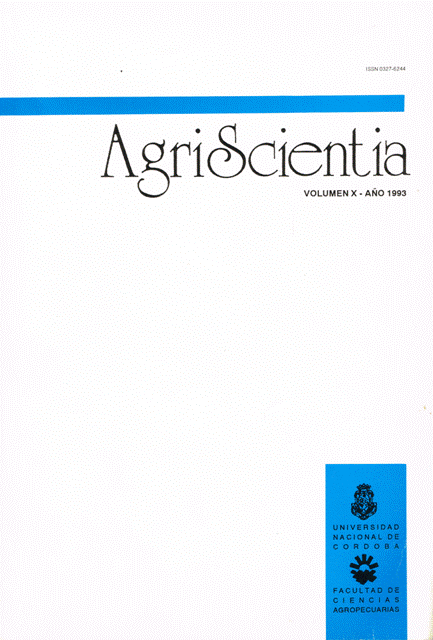Senescence in leaves of Avena sativa cv. Suregrain. Effect of energy metabolism blockers
Main Article Content
Abstract
The relationship among energy metabolism, changes in membrane permeability and oxidation levels were analyzed using Avena leaves incubated in vitro with a medium containing inhibitors of energetic metabolism, such as EDTA, KCN, DCMU, DNP, and Tritón X-100. Results showed that all of the energetic metabolism inhibitors increased senescence parameters, measured as changes in permeability, chlorophyll degradation, and proteolysis, so the relationship between energy decrease and senescence was confirmed. The fact that energetic metabolism inhibitors were accompanied by stimulation of MDA content suggested that the effect of energy metabolism decrease could be mediated by an increase in cell oxidation levels. As cysteine, a SH group protector, delayed the development of all the parameters measured, oxidation damages would involve an attack on SH groups of cell proteins.
Article Details
Issue
Section

This work is licensed under a Creative Commons Attribution-ShareAlike 4.0 International License.
How to Cite
References
Arnon, D.I., & Chain, R.K. (1975). Regulation of ferredoxin-catalyzed photosynthetic phosphorylation. Proceedings of the National Academy of Sciences USA, 72, 4961-4965.
Arntzen, C.J., Darr, S.C., Mullat, J.E., Steinback, K.E., & Pfister, K. (1982). Polypeptid determinants of plastoquinone function in photosystem II of chloroplasts. In B.L. Trumpower (Ed.), Function of quinones in energy conserving systems (pp. 443-452). New York: Academic Press.
Avron, M. (1981). Photosynthetic electron transport and photophosphorylation. In M.D. Hatch & N.K. Boardman (Eds.), The Biochemistry of plants: Photosynthesis (pp. 163-191). New York: Academic Press.
Dean, R.T., & Pollak, J.K. (1985). Endogenous free radical generation may influence proteolysis in mitochondria. Biochemical and Biophysical Research Communications, 126(3), 1082-1089.
Enami, J., & Kura-Hotta, M. (1984). Effect of intracellular ATP levels on the light-induced H+ efflux from intact cells of Cyanidium caldarium. Plant and Cell Physiology, 25(7), 1107-1113.
Hachimori, A., Nosoh, Y., & Sone, N. (1968). Effects of the photosynthetic inhibitors on the respiration of yeast mitochondria. Journal of Biochemistry Tokyo, 64, 119-121.
Heath, R.L., & Packer, L. (1968). Photoperoxidation in isolated chloroplasts: I. Kinetics and stoichiometry of fatty acid peroxidation. Archives of Biochemistry and Biophysics, 125, 189-198.
Jagendorf, A.T. (1977). Photophosphorylation. In A. Trebst & M. Avron (Eds.), Photosynthesis (pp. 307-336). New York: Springer Verlag.
Jeanjean, R. (1976). The effect of metabolic poisons on ATP level and on active phosphate uptake in Chlorella pyrenoidosa. Physiologia Plantarum, 37, 107-110.
Kinraide, T.B., & Etherton, B. (1982). Energy coupling in H+, amino acid cotransport. Plant Physiology, 69, 648-652.
Luna, C.M., & Trippi, V.S. (1986). Membrane permeability: Regulation by exogenous sugars during senescence of oat leaf in light and darkness. Plant and Cell Physiology, 27, 1051-1062.
Malik, N.S.A., & Thimann, K.V. (1980). Metabolism of oat leaves during senescence: VI. Changes in ATP levels. Plant Physiology, 65, 855-858.
Moreland, D.E. (1980). Mechanisms of action of herbicides. Annual Review of Plant Physiology, 31, 597-638.
Moore, S., & Stein, W.H. (1948). Photometric ninhydrin method for use in the chromatography of amino acids. Journal of Biological Chemistry, 176, 367-388.
Murphy, T.M. (1984). Effect of sulfhydryl reagents on K+ efflux from rose cells. Plant Physiology, 75, 138-141.
Renger, G. (1973). The action of 3-(3,4-dichlorophenyl)-1,1-dimethylurea on the water-splitting enzyme system of photosynthesis. Biochimica et Biophysica Acta, 314, 113-116.
Sailer, S.O., & Thimann, K.V. (1980). The influence of aliphatic alcohols on leaf senescence. Plant Physiology, 66, 395-399.
Solomos, T. (1977). Cyanide-resistant respiration in higher plants. Annual Review of Plant Physiology, 28, 279-297.
Tetley, R.M., & Thimann, K.V. (1974). The metabolism of oat leaves during senescence: I. Respiration, carbohydrate metabolism and the action of cytokinins. Plant Physiology, 54, 294-303.
Trippi, V.S., & Thimann, K.V. (1983). The exudation of solutes during senescence of oat leaves. Physiologia Plantarum, 58, 21-28.
Trippi, V.S., & Paulin, A. (1984). The senescence of cut carnations: A phasic phenomenon. Physiologia Plantarum, 60, 221-226.
Trippi, V.S., & De Luca d'Oro, G.M. (1985). The senescence process in oat leaves and its regulation by oxygen concentration and light irradiance. Plant and Cell Physiology, 26(7), 1303-1311.
Trippi, V.S., Paulin, A., & Pradet, A. (1988). Effect of oxygen concentration on the senescence and energy metabolism of cut carnation flowers. Physiologia Plantarum, 73, 374-379.
Trippi, V.S., Gidrol, X., & Pradet, A. (1989). Effects of oxidative stress caused by oxygen and hydrogen peroxide on energy metabolism and senescence in oat leaves. Plant and Cell Physiology, 30(2), 157-162.
Woolhouse, H.W. (1984). The biochemistry and regulation of senescence in chloroplasts. Canadian Journal of Botany, 62, 2934-2942.





